Self-sown in so many places that it might seem it is native, it is not. Red valerian is native to the Mediterranean region of southern Europe and North Africa, and, despite its southerly origins, it is quite hardy. It survived in many areas in the two hard winters of a decade ago, especially in the coastal areas of milder temperature levels. It is also seen a lot in towns where is colonizes old stone walls. It can be seen in rural areas occasionally too, growing in old walls, especially granite-built walls.
The plant, Centranthus ruber, does remarkably well in the tough conditions of a stone wall because it likes very good drainage. In its native habitat, it grows on dry, rocky, sunny slopes, usually in limestone areas. The old stone walls were built with lime mortar, which is soft and allows roots to penetrate. Red valerian makes a tough woody rootstock from which the flowering stems sprout each year.
When it is growing in an old wall or in very dry ground, the plant’s vigour is curbed and the plant grows hard and drought-resistant. But if it is grown in good fertile soil with plenty of moisture, it can become very leafy and vigorous.
It will still flower but not as well and the leafy flower stems tend to be relatively soft with the likelihood that they will fall over. Quite often, these over-fed clumps just split open in the middle and the stems flop around in a circle.
Red valerian is related to the wild native valerian of marshy ground and its small flowers are similar but the wild valerian is more upright with palest pink white flowers in flat-topped clusters. The flowers of the red valerian are usually more rounded or conical in the cluster, and though called valerian – they being members of the valerian family – they are very different plants, not least in their demand for moisture.
Red valerian is related to the wild native valerian of marshy ground and its small flowers are similar but the wild valerian is more upright
After flowering, the flowers produce seeds with a downy attachment that carries them on the slightest breeze. Some fall close to the parent and sprout, others are carried to further places, including the top of walls where rainwater washes the seeds into suitable cracks to germinate.
Plants growing in dry places can last for a long-time while those in good soil tend to die out. Although it can be too luxuriant in rich garden soil, if the spot is chosen well – say the edge of a gravel path or a dry spot under a wall – red valerian has a place in gardens. Although seedlings are produced commonly, it is generally not a nuisance self-sower as it needs very dry rocky soil or old walls. To prevent seeding, the flowers can be snipped off before seeds form and this will tend to encourage new flowers. Few plants are as prolific with flowers.
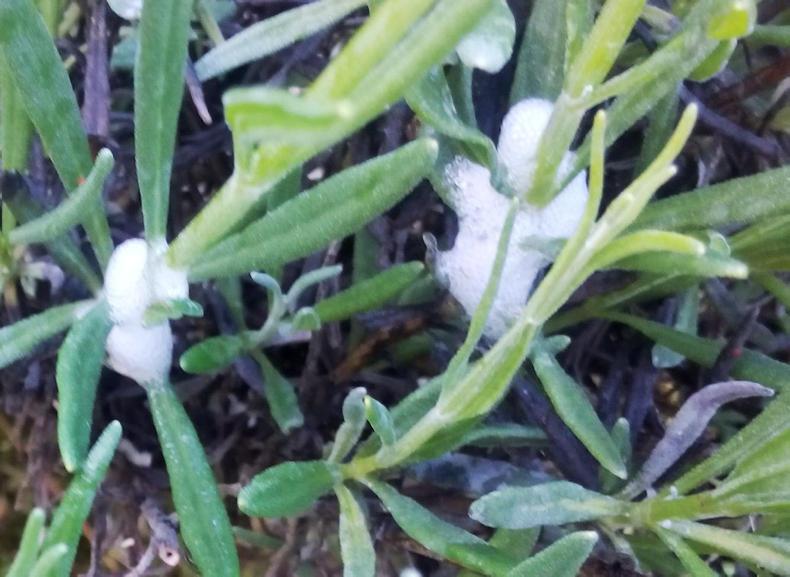
Frog hopper.
Lavender comes into flower in mid-summer and it is not uncommon to see white frothy masses on the stems. This is known in many parts of the country as “cuckoo spit”, but about the only connection with the cuckoo is that it too is associated with June as it is often heard calling in that month. The cuckoo spit is actually a clever protective strategy by a little insect called a frog hopper.
The larval stages of this little bug hide in the foam. Open the foam to find the little frog-like insect. The foam is made of bubbles produced by the insect from plant juices. It hides the insect from birds that might want to eat it, but it also keeps the insect’s outer skin supple by keeping it moist and the foam tastes very nasty, which keeps birds and other predators at bay. Lavender is not the only garden plants that may play host to this insect and it is common on plants of many kinds, but it is very noticeable on lavender. If you consider it unsightly, you can simply wash it off with a jet spray of water from a hose, but you might decide to leave the frog hopper in his cloud of wet bubbles!
Trees, shrubs and roses
Many young trees, shrubs, hedges and roses should be watered heavily to get water down to the roots. Watering should be carried out about once every week or ten days if the conditions remain dry at the root. Very often, people notice the trees wilting and water but do not apply enough to penetrate to the roots. The same happens with showers of rain that are not heavy enough to penetrate.
Flowers
Containers of all kinds will need frequent watering, every day if the weather is hot and dry. Fortunately, warm weather also improves the results from flowers in pots. Most of them need warm weather to perform to their best. Feeding is also essential at this stage and can be given in every third or fourth watering. Take of the flower heads off garden flowers, eg foxgloves and lady’s mantle, that are likely to shed seeds.
Lawns
Lawns came under pressure in dry weather, especially on light soils. Green lawns need to be fed now, if they have not already got it. Be careful to wait until rain is forecast because the grass will scorch if the weather turns dry. Wildflower lawn is not cut back by mowing as often, and no fertiliser is added so as to disfavour the grass and grow the wild flower lawn. No weed-killed is ever used.
Greenhouse and house plants
Be sure to water plants in pots or grow-bags regularly, because they can easily dry out. Spray a grapevine if it shows mildew to keep the fungus off the tiny grapes. Continue watering and feeding greenhouse plants. Train and side-shoot tomatoes and cucumbers.
Fruit, vegetables and herbs
Potato blight turns up about now usually and control should be kept up, especially for maincrop potatoes. After a slow start, there has been good growth recently of sweet corn, which likes heat. Make some late sowings of lettuce and radishes. If the soil is dry, peas and cabbages should be watered to keep the plants growing. Be careful about watering carrots because they often crack if a lot of water is given.
Read more
In the garden with Gerry Daly: butterfly bushes
In the garden with Gerry Daly: tower flowers
Self-sown in so many places that it might seem it is native, it is not. Red valerian is native to the Mediterranean region of southern Europe and North Africa, and, despite its southerly origins, it is quite hardy. It survived in many areas in the two hard winters of a decade ago, especially in the coastal areas of milder temperature levels. It is also seen a lot in towns where is colonizes old stone walls. It can be seen in rural areas occasionally too, growing in old walls, especially granite-built walls.
The plant, Centranthus ruber, does remarkably well in the tough conditions of a stone wall because it likes very good drainage. In its native habitat, it grows on dry, rocky, sunny slopes, usually in limestone areas. The old stone walls were built with lime mortar, which is soft and allows roots to penetrate. Red valerian makes a tough woody rootstock from which the flowering stems sprout each year.
When it is growing in an old wall or in very dry ground, the plant’s vigour is curbed and the plant grows hard and drought-resistant. But if it is grown in good fertile soil with plenty of moisture, it can become very leafy and vigorous.
It will still flower but not as well and the leafy flower stems tend to be relatively soft with the likelihood that they will fall over. Quite often, these over-fed clumps just split open in the middle and the stems flop around in a circle.
Red valerian is related to the wild native valerian of marshy ground and its small flowers are similar but the wild valerian is more upright with palest pink white flowers in flat-topped clusters. The flowers of the red valerian are usually more rounded or conical in the cluster, and though called valerian – they being members of the valerian family – they are very different plants, not least in their demand for moisture.
Red valerian is related to the wild native valerian of marshy ground and its small flowers are similar but the wild valerian is more upright
After flowering, the flowers produce seeds with a downy attachment that carries them on the slightest breeze. Some fall close to the parent and sprout, others are carried to further places, including the top of walls where rainwater washes the seeds into suitable cracks to germinate.
Plants growing in dry places can last for a long-time while those in good soil tend to die out. Although it can be too luxuriant in rich garden soil, if the spot is chosen well – say the edge of a gravel path or a dry spot under a wall – red valerian has a place in gardens. Although seedlings are produced commonly, it is generally not a nuisance self-sower as it needs very dry rocky soil or old walls. To prevent seeding, the flowers can be snipped off before seeds form and this will tend to encourage new flowers. Few plants are as prolific with flowers.

Frog hopper.
Lavender comes into flower in mid-summer and it is not uncommon to see white frothy masses on the stems. This is known in many parts of the country as “cuckoo spit”, but about the only connection with the cuckoo is that it too is associated with June as it is often heard calling in that month. The cuckoo spit is actually a clever protective strategy by a little insect called a frog hopper.
The larval stages of this little bug hide in the foam. Open the foam to find the little frog-like insect. The foam is made of bubbles produced by the insect from plant juices. It hides the insect from birds that might want to eat it, but it also keeps the insect’s outer skin supple by keeping it moist and the foam tastes very nasty, which keeps birds and other predators at bay. Lavender is not the only garden plants that may play host to this insect and it is common on plants of many kinds, but it is very noticeable on lavender. If you consider it unsightly, you can simply wash it off with a jet spray of water from a hose, but you might decide to leave the frog hopper in his cloud of wet bubbles!
Trees, shrubs and roses
Many young trees, shrubs, hedges and roses should be watered heavily to get water down to the roots. Watering should be carried out about once every week or ten days if the conditions remain dry at the root. Very often, people notice the trees wilting and water but do not apply enough to penetrate to the roots. The same happens with showers of rain that are not heavy enough to penetrate.
Flowers
Containers of all kinds will need frequent watering, every day if the weather is hot and dry. Fortunately, warm weather also improves the results from flowers in pots. Most of them need warm weather to perform to their best. Feeding is also essential at this stage and can be given in every third or fourth watering. Take of the flower heads off garden flowers, eg foxgloves and lady’s mantle, that are likely to shed seeds.
Lawns
Lawns came under pressure in dry weather, especially on light soils. Green lawns need to be fed now, if they have not already got it. Be careful to wait until rain is forecast because the grass will scorch if the weather turns dry. Wildflower lawn is not cut back by mowing as often, and no fertiliser is added so as to disfavour the grass and grow the wild flower lawn. No weed-killed is ever used.
Greenhouse and house plants
Be sure to water plants in pots or grow-bags regularly, because they can easily dry out. Spray a grapevine if it shows mildew to keep the fungus off the tiny grapes. Continue watering and feeding greenhouse plants. Train and side-shoot tomatoes and cucumbers.
Fruit, vegetables and herbs
Potato blight turns up about now usually and control should be kept up, especially for maincrop potatoes. After a slow start, there has been good growth recently of sweet corn, which likes heat. Make some late sowings of lettuce and radishes. If the soil is dry, peas and cabbages should be watered to keep the plants growing. Be careful about watering carrots because they often crack if a lot of water is given.
Read more
In the garden with Gerry Daly: butterfly bushes
In the garden with Gerry Daly: tower flowers






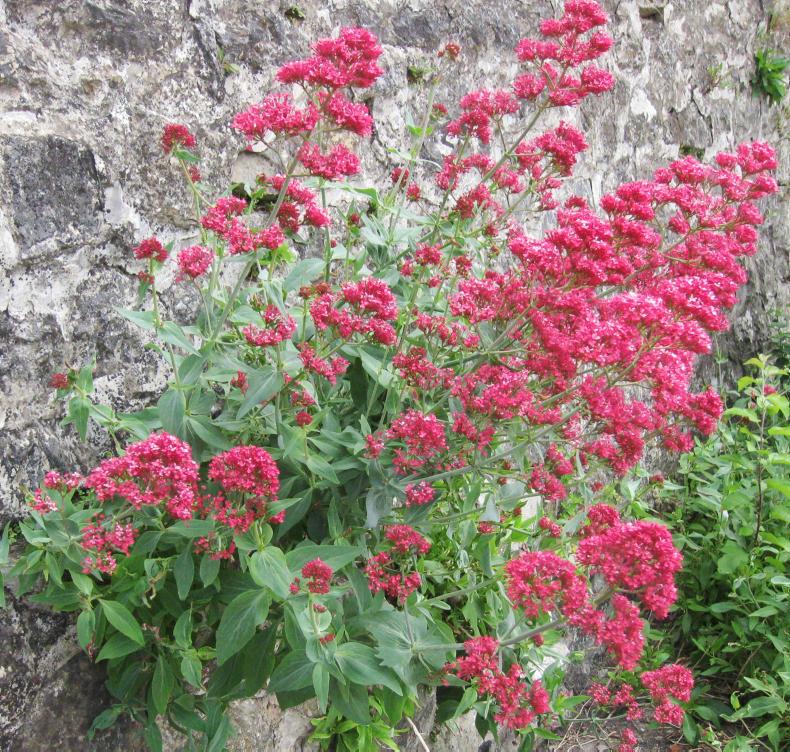
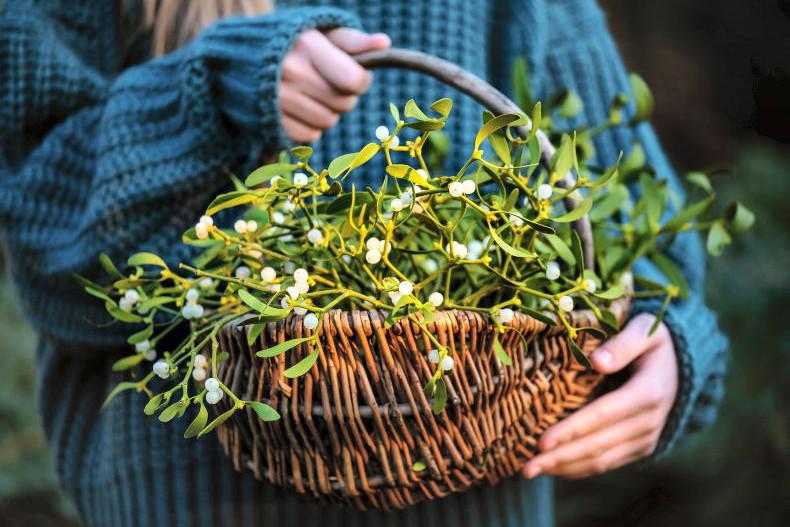
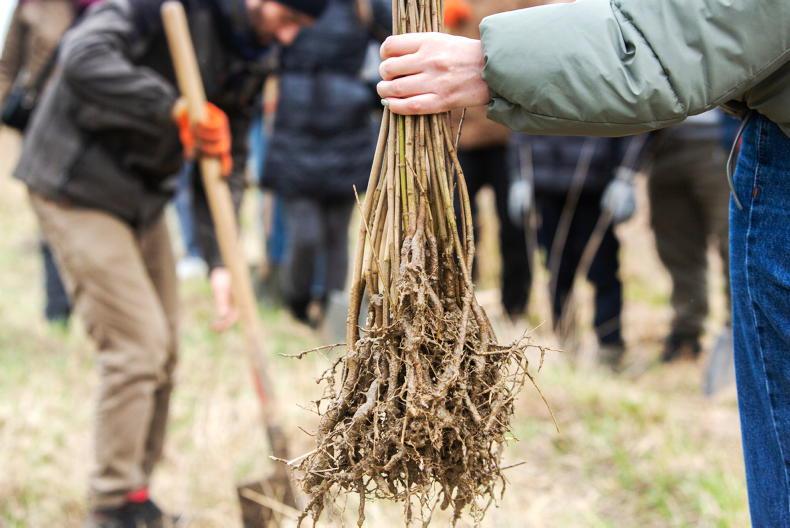

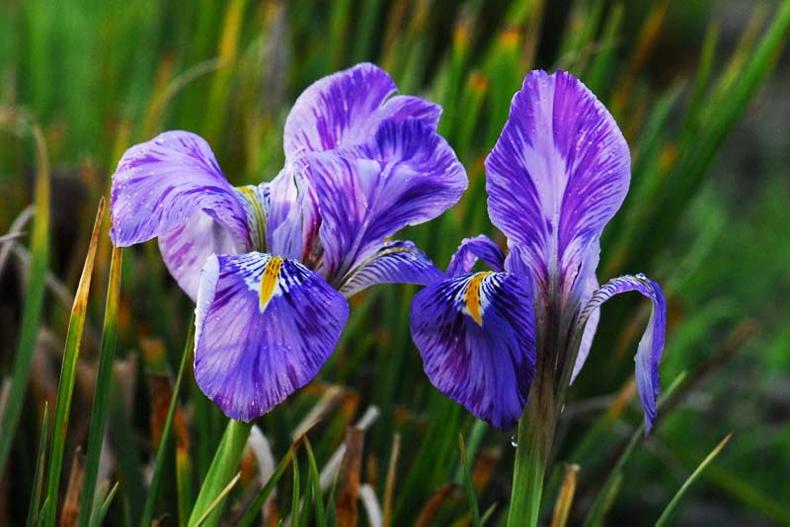
SHARING OPTIONS